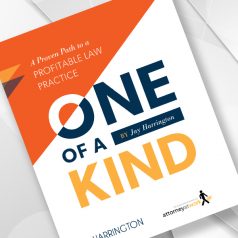Law firm marketing strategies involve a mindset shift towards digital marketing to reach clients in an increasingly online-focused world.

Key Takeaways
- Law Firm Marketing is Key: In a crowded legal market you need to have a law firm marketing strategy to stand out, attract new clients and build a brand. This means identifying your target market, creating a unique value proposition and using various marketing channels like SEO, social media and content marketing.
- Trust over Attention: Law firms can buy attention with big advertising campaigns but trust can’t be bought. Trust is built with a strategic approach that involves understanding the client’s needs, telling a compelling story and delivering on promises. Law firm marketing gurus say trust is the foundation of all marketing.
- Focus on Current Clients: Retaining current clients is cheaper than acquiring new ones. Law firms should focus their marketing on building relationships with existing clients as increasing client retention rates can increase profits. This means understanding client needs, delivering great service and building long term loyalty.
In the classic ‘80s comedy “Brewster’s Millions,” Richard Pryor plays a minor league baseball player who has to spend $30 million in 30 days in order to inherit $300 million from his great-uncle. Predictably, he goes on a wild spending spree (for example, he purchases a rare stamp and uses it to mail a letter) in an effort to exhaust his budget.
Sure, You Can Buy Attention …
Times are good for many law firms. Revenues and profits are up. There is a margin to spend on marketing. While most firms do not engage in wild spending sprees, in times like these things tend to get a little loose. When the coffers are full, it’s tempting to invest in large-scale, attention-grabbing marketing campaigns.
Establishing a law firm marketing budget is crucial as it enables firms to manage costs, forecast returns on investment, and assess the overall success of their marketing initiatives.
For example, you can buy attention by spending $500,000 on a national advertising campaign. And if you do this frequently and consistently enough, it will work — if what you want is broad brand awareness. While it’s almost impossible to measure the actual ROI of this type of marketing, it feels good to have your firm’s logo splashed across print publications and airport kiosks.
But what about for everybody else? And what happens when things turn south?
Unfortunately, instead of doing something different, many firms make one-off investments (a single, full-page ad in the local business journal) meant to mimic their larger counterparts. But this doesn’t result in the type of sustained business success they’re seeking.
But You Can’t Buy Trust
Yes, you can buy attention. But no matter how much you spend, you can’t buy trust. And trust is the most valuable form of currency needed to sell sophisticated professional services.
Effective marketing that garners both attention and trust must be built on a foundation of strategy. Developing an effective strategy requires an investment, but not merely writing a check. It involves listening, understanding, being empathetic, and putting in the labor necessary to truly know who your audience is and what matters to it. Law firm marketing experts play a crucial role in this process by crafting strategies that build trust through their deep understanding of complex advertising features and current SEO practices. Only then can marketing tactics be deployed that will lead people to enroll in what you have to say and then open the door to your business development overtures.
Laying a strong foundation for effective legal marketing and business development is hard work. It requires a mindset shift. It involves thinking unconventionally.
These Law Firm Marketing Strategies Are Not for Everyone
What follows are not tactics. Rather, these are 10 maxims that will help you frame the decisions and, yes, make the investments necessary to make an impact with your legal marketing. These are principles. And they’re not for everyone.
Undoubtedly, many lawyers and law firms will continue to do things the way they’ve always been done: establishing a budget, outsourcing marketing and checking the box.
However, having a comprehensive law firm marketing plan is essential for attracting new clients and building a strong brand. It should include key components like SEO, content marketing, and remarketing strategies to optimize marketing efforts and ensure effective lead generation.
This is for the rest of you.
Understanding Law Firm Marketing Strategies
In a competitive landscape of legal services, having a solid marketing strategy is not just an option—it’s a necessity. Law firm marketing strategies involve a comprehensive plan that outlines how a law firm will achieve its marketing goals and objectives. This strategic approach is important for standing out in a crowded market, attracting new clients, and building business.
A well-crafted marketing strategy begins with identifying your target audience. Who are the prospective clients you want to reach? Understanding their needs, preferences, and pain points is important. Once you have a clear picture of your audience, the next step is to develop a unique value proposition (UVP) that sets your firm apart from competitors. This UVP should resonate with your target audience, communicating the benefits and value your firm offers.
Using various marketing channels is another component. From search engine optimization (SEO) to social media marketing, each channel plays a role in reaching prospective clients. A strategic mix of these channels sends your message loud and clear, driving traffic to your law firm’s website and converting visitors into clients.
What is a Marketing Strategy for Law Firms?
A marketing strategy for law firms is a detailed blueprint that outlines how a firm will achieve its marketing goals. It involves several key components:
- Identifying the Target Audience: Knowing who your prospective clients are is the first step. This involves understanding their demographics, needs, and behaviors.
- Developing a Unique Value Proposition (UVP): Your UVP is what sets you apart from other law firms. It should clearly communicate the unique benefits and value you offer.
- Creating a Strong Brand: Your brand is more than just your logo or tagline. It’s the overall perception of your firm in the minds of your clients.
- Utilizing Various Marketing Channels: From SEO and content marketing to social media and email campaigns, a diverse mix of channels helps you reach a broader audience.
A well-thought-out marketing strategy is key for law firms to differentiate themselves in a competitive market, attract new clients, and grow their business.
1. Clients Don’t Care About You.
Of course not — they care about themselves. So why is so much of your marketing focused on facts, figures and features about your firm? Stop fixating on the utility of what you do, and understand that clients — like all consumers — act based on how they feel. The story you tell, not the services you provide nor the accolades you’ve earned, is what creates emotional resonance and engenders trust. A well-optimized law firm’s website can be a powerful tool for engaging clients and building that emotional connection.
2. Clients Don’t Buy Legal Services — They Buy Outcomes.
But not the outcomes you think. Sure, your plaintiff-client wants to win the lawsuit. But she brought the lawsuit because she felt overlooked, disrespected and cheated in some way. She wants redemption. These feelings keep her up at night. What she’s really buying is a good night’s sleep. Are you focused solely on the lawsuit? Are you spending more time corresponding with opposing counsel and the judge’s clerk than with your client? Or are you giving her what she truly seeks: comfort, security and confidence that she’s entrusted her peace of mind to someone who deeply understands what matters to her?
Don’t conflate your own ambitions with your client’s desired outcome. Use your law firm website to showcase successful outcomes and demonstrate your commitment to client satisfaction.
3. The Status Quo Is Your Biggest Competition.
Most people and businesses who are in the market for legal services are already clients of other lawyers and law firms. Your job, therefore, is not to offer a marginally better option. Despite what’s taught in undergrad economics class, consumers are not rational actors. They don’t weigh options equally and always make the better choice. They’re gripped by inertia. They view change as risky, despite the availability of a better alternative. They’re beholden to the status quo. And so are you. To overcome this, developing a comprehensive law firm marketing strategy is essential.
4. You Have to Give Them a Reason to Change.
Because consumers are gripped by inertia, you need to formulate and articulate a significantly superior offer if you hope to shake prospects free of the status quo. You have to craft a compelling story that demonstrates the value of change. This will gain you attention. And gaining someone’s attention will give you the opportunity to earn their trust. Consistently build trust by making and keeping promises with a sense of urgency, and the change you seek will happen. Implementing a well-defined legal marketing strategy can help law firms effectively reach potential clients and align their marketing objectives with their goals, enhancing visibility and client engagement.
5. Forget Mass Markets — Focus on One Person at a Time.
Most marketing is focused on reaching mass markets. Why not reach everyone you can? Because, if you try, you’ll reach no one. Your message will be watered down and, therefore, ignored. Mass marketing is lazy and is based on the conceit that large numbers of prospective clients will be interested in what you have to say. Focus instead on reaching a minimum viable market. Before shooting for 50 new clients, aim for five. Dial-in on a small group of people. Serve them. Delight them. Then they’ll tell a friend. Their word-of-mouth recommendations to others in the small group you hope to serve will be far more valuable than any message you can broadcast to mass markets.
Smaller firms often face challenges when they cannot afford a law firm marketing agency. However, strategic tips can help these lawyers implement effective digital marketing strategies despite financial constraints.
Building a Strong Brand
In the legal industry, a strong brand is a powerful asset. It not only helps in attracting prospective clients but also in building trust and credibility. A key element of brand building is developing a unique value proposition (UVP).
Develop a Unique Value Proposition (UVP)
A unique value proposition (UVP) is a statement that clearly communicates the benefits and value that a law firm offers to its clients. It should be concise, compelling, and relevant to the target audience. For example, a law firm’s UVP might be: “We provide personalized and compassionate legal services to individuals and families, helping them navigate complex legal issues with confidence and peace of mind.”
A strong UVP helps law firms establish a distinct brand identity. It differentiates the firm from competitors and resonates with prospective clients, making them more likely to choose your services over others. By clearly articulating what makes your firm unique, you can build trust and drive business growth.
In conclusion, developing a UVP is not just about crafting a catchy slogan. It’s about understanding your clients’ needs and positioning your firm as the best solution to meet those needs. This strategic approach to branding is important for any law firm looking to succeed in today’s competitive market.
6. Tactics are Not Strategy — They Serve Strategy.
One of the most common questions I get this time of year, as law firms plan for the next one, is: “What do you see other firms doing that is working?” At the root of this question is: What tactics are generating buzz and business? In my experience, the only tactic that works is eschewing tactics altogether until strategy and story are dialed in. Your website, email marketing, social media, print ads, podcasts, videos … the list goes on and on. Those are just the means of distribution. They’re just channels. Forget tactics — at least for now. Craft a great story that you can tell a distinct audience. Establishing a marketing budget as a component of a law firm’s marketing strategy will help control costs and measure the return on investment. Then, and only then, use tactics to spread your message.
7. Thought Leadership is Generous (which is why it works).
Thought leadership marketing involves freely sharing informative, educational, and inspiring content in the marketplace of ideas. Many lawyers are afraid to engage in thought leadership marketing. They don’t want to give away the “secret sauce.” This type of thinking is misguided. Clients aren’t looking to do it themselves. They’re looking for the right expert for the job. If your ideas resonate and help your prospects to understand that you have a solution to the problems they face, you’ll distinguish yourself from other lawyers who are leading with their bios. If you consistently show up in front of your target audience and generously share your thought leadership, you’ll be rewarded. The people who matter to you will start to view you as an insider who can be trusted, not as an outsider who is held at arm’s-length. If you’re hesitant to share your best ideas with those you hope to serve, keep in mind that one (or more) of your competitors is already doing so.
8. To Achieve Big Success, Start by Thinking Small.
Having a niche focus is important for many reasons. A principal one is to establish yourself as a thought leader. It’s almost impossible to be a thought leader and not have a niche. To have insights and ideas that breakthrough and change the conversation, you need to have a focus. You need to commit. You need to aim for depth, not breadth. An unexpected, counterintuitive (and wonderful) thing happens when you commit, and shut down all the distractions, side projects, “what-if” and “just-in-case” initiatives. More opportunities come your way when you do less but do it better than anyone else. Want sophisticated, high-paying clients with interesting projects? These types of clients are looking for a result, not a bargain, and are willing to pay for the best alternative out there.
A lawyer who merely dabbles across a number of domains will almost certainly not achieve the thought leader status required to be in the running for this type of work. The same goes for speaking and writing opportunities, and opportunities to build relationships with other thought leaders. Less leads to more.
9. First Impressions Matter More Than You Think.
Think about the last time you interviewed a job candidate or a vendor for a project. If you’re like most people, you made a snap judgment (positive or negative) within the first few minutes of meeting the person. The rest of the conversation was merely polite chitchat. Your prospective clients do this, too. The problem lawyers and law firms face, however, is that it’s almost impossible to know the point of first impression for most prospects. In some cases, it’s a chat over coffee. Other times, it’s an opinion shared by someone who has had prior dealings with your firm. These days, it’s likely to be an online interaction involving a prospect doing due diligence via a firm website or lawyer LinkedIn profile.
So what to do? Audit and improve your points of first impression. Make each potential touch-point as meaningful, welcoming and relevant as possible. First impressions matter greatly. And the challenge you face is that many are being formed without you even knowing it.
10. Your Best Prospects are Those You Already Serve.
It’s exciting to develop new business from new clients. But trying to get new business from new clients is the wrong place to focus your marketing resources. Depending on which study you reference, acquiring a new customer or client is anywhere from 5 to 25 times more expensive than retaining an existing one. And research from Bain & Co. suggests that increasing customer or client retention rates by 5 percent increases profits by 25 to 95 percent. Don’t chase. Dance with the one that brought you.
Now What?
If you made it this far, you may be thinking, “What am I supposed to do with this?” That’s kind of the point. You’re not supposed to do anything, at least not yet. First, you need to think.
Ask yourself:
- Who am I trying to serve?
- What matters to them? How do they see the world?
- What do I have to offer that is new and different?
- What small steps can I take to gain the attention of a small group of people, and break through the status quo?
- With that attention, how will I build trust?
- How can I serve my audience?
- How can I build the capacity (time, discipline, resilience) to show up, and be generous, over and over again?
- How can I keep the promise of my marketing by delivering even more than what was expected?
The answer to all of these questions is something other than: write a check, place an ad, outsource it to someone else. Struggling and grappling with these issues is the hard work of marketing. If you want to grow your practice, it’s one of the best investments you can make.
Updated July. 2024. Image ©iStockPhoto.com.

















